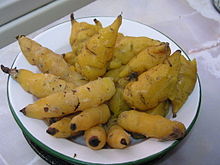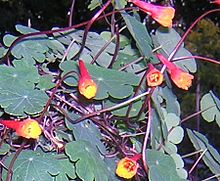- Mashua
-
Mashua 
Yellow mashua with yellow oca Scientific classification Kingdom: Plantae (unranked): Angiosperms (unranked): Eudicots (unranked): Rosids Order: Brassicales Family: Tropaeolaceae Genus: Tropaeolum Species: T. tuberosum Binomial name Tropaeolum tuberosum
Ruíz and PavónThe mashua (see below for other names) is a perennial plant grown in the Andes for its edible tuber, which is eaten as a root vegetable. It is a major food source there. The tuber is rather peppery in flavor[1] when raw, but this quality disappears when cooked. It is related to garden nasturtiums, being of the Tropaeolum genus, not to be confused with the genus Nasturtium.
Contents
Alternative names
This plant is commonly called mashua in Peru and Ecuador,[2] but other names include:
- Mashwa
- Maswallo
- Mazuko
- Mascho (Peru)
- Añu (in Peru and Bolivia)
- Isaño
- Cubio (in Colombia)
- Tuberous Nasturtium
Growing mashua
The plant grows vigorously even in marginal soils and in the presence of weeds. It is also well-adapted to high-altitude subsistence agriculture, and gives high yields; 30 tonnes per hectare are yielded at a height of 3000 metres, but up to 70 tons per hectare have been produced under research conditions.[3]
Its extraordinary resistance to insect, nematode, and bacterial pests is attributed to high levels of isothiocyanates. In Colombia, it is planted as a companion crop to repel pests in potato fields.
Mashua as a food
The tubers comprise as much as 75 percent of the mature plants by dry weight (40 percent is typical for cereals)[citation needed]. Up to 75 percent of dry matter reaches the tubercle.[2]
Popularization of mashua may be limited by its strong flavor, and its reputation as an anaphrodisiac (see below).
Medicinal properties
It has been recorded by the Spanish chronicler Cobo that mashua was fed to their armies by the Inca Emperors, "that they should forget their wives".[3][4] Indeed, studies of male rats fed on mashua tubers have shown a 45% drop in testosterone levels.[3]
Mashua has also been used to treat nephropathy, and as a diuretic.[citation needed]
See also
Literature
References
- ^ 10 perennial veggies to grow, San Francisco Gate
- ^ a b Peace Diaries Workspace
- ^ a b c Mashua Ethnobotanical Leaflet, Southern Illinois University
- ^ Lost Crops of the Incas: Little-Known Plants of the Andes with Promise for Worldwide Cultivation, National Academies Press

This Brassicales article is a stub. You can help Wikipedia by expanding it.

